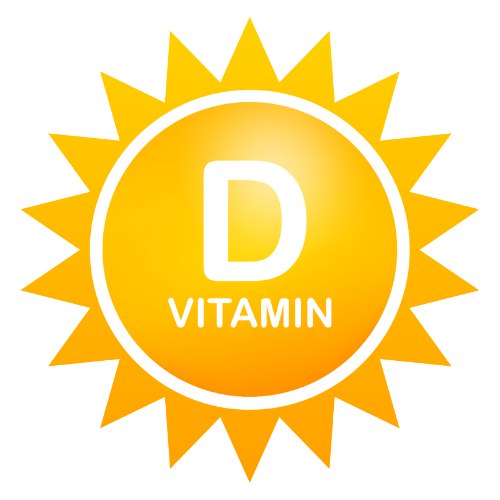Vitamin D (also referred to as calciferol) is a fat-soluble vitamin that is naturally present in a few foods, added to others, and available as a dietary supplement. It is also produced endogenously when ultraviolet (UV) rays from sunlight strike the skin and trigger vitamin D synthesis.

Vitamin D promotes calcium absorption in the gut and maintains adequate serum calcium and phosphate concentrations to enable normal bone mineralization and to prevent hypocalcemic tetany (involuntary contraction of muscles, leading to cramps and spasms).
Absorption occurs by simple passive diffusion and by a mechanism that involves intestinal membrane carrier proteins. The presence of fat in the gut enhances vitamin D absorption, but some vitamin D is absorbed even without dietary fat. Neither ageing nor obesity alters vitamin D absorption.
Sometimes the amount of vitamin D is expressed as International Units (IU). 1 microgram of vitamin D is equal to 40 IU. So 10 micrograms of vitamin D is equal to 400 IU.
Assessing vitamin D status by measuring serum 25(OH) D concentrations is complicated by the considerable variability of the available assays (the two most common ones involve antibodies or chromatography) used by laboratories that conduct the analyses. As a result, a finding can be falsely low or falsely high, depending on the assay used and the laboratory.
People at risk of vitamin D deficiency
Some people will not make enough vitamin D from sunlight because they have very little or no sunshine exposure.
The Department of Health and Social Care recommends that adults and children over 4 take a daily supplement containing 10 micrograms of vitamin D throughout the year if they:
- are not often outdoors – for example, if they’re frail or housebound
- are in an institution like a care home
- usually wear clothes that cover up most of their skin when outdoors
If you have dark skin – for example you have an African, African-Caribbean or south Asian background – you may also not make enough vitamin D from sunlight.
How much Vitamin D should we take?
If you choose to take vitamin D supplements, 10 micrograms a day will be enough for most
Do not take more than 100 micrograms (4,000 IU) of vitamin D a day as it could be harmful. This applies to adults, including pregnant and breastfeeding women and the elderly, and children aged 11 to 17 years.
Issues caused by lack of Vitamin D
Bone health and osteoporosis
Vitamin D is also needed for bone growth and bone re modelling by osteoblasts and osteoclasts. Without sufficient vitamin D, bones can become thin, brittle, or misshapen. Vitamin D sufficiency prevents rickets in children and osteomalacia in adults. Together with calcium, vitamin D also helps protect older adults from osteoporosis.
Bone is constantly being remodelled. However, as people age—and particularly in women during menopause—bone breakdown rates overtake rates of bone building. Over time, bone density can decline, and osteoporosis can eventually develop.
Depression
Vitamin D is involved in various brain processes, and vitamin D receptors are present on neurons and glia in areas of the brain thought to be involved in the pathophysiology of depression.
Food

In foods and dietary supplements, vitamin D has two main forms, D2 (ergocalciferol) and D3 (cholecalciferol), that differ chemically only in their side-chain structures.
Both forms are well absorbed in the small intestine.
Few foods naturally contain vitamin D. The flesh of fatty fish (such as trout, salmon, tuna, and mackerel) and fish liver oils are among the best sources. An animal’s diet affects the amount of vitamin D in its tissues. Beef liver, egg yolks, and cheese have small amounts of vitamin D, primarily in the form of vitamin D3 and its metabolite 25(OH)D3. Mushrooms provide variable amounts of vitamin D2. Some mushrooms available on the market have been treated with UV light to increase their levels of vitamin D2.
Sun exposure
Most people in the world meet at least some of their vitamin D needs through exposure to sunlight. Type B UV (UVB) radiation with a wavelength of approximately 290–320 nanometers penetrates uncovered skin and converts cutaneous 7-dehydrocholesterol to previtamin D3, which in turn becomes vitamin D3.
Season, time of day, length of day, cloud cover, smog, skin melanin content, and sunscreen are among the factors that affect UV radiation exposure and vitamin D synthesis. Older people and people with dark skin are less able to produce vitamin D from sunlight. UVB radiation does not penetrate glass, so exposure to sunshine indoors through a window does not produce vitamin D.
What happens if I take too much vitamin D?
Taking too many vitamin D supplements over a long period of time can cause too much calcium to build up in the body (hypercalcaemia). This can weaken the bones and damage the kidneys and the heart.
Interactions with Medications
Vitamin D supplements may interact with several types of medications. A few examples are provided below. Individuals taking these and other medications on a regular basis should discuss their vitamin D intakes and status with their health care providers.
Orlistat
The weight-loss drug orlistat (Xenical and alli), together with a reduced-fat diet, can reduce the absorption of vitamin D from food and supplements, leading to lower 25(OH)D levels [164-167].
Statins
Statin medications reduce cholesterol synthesis. Because endogenous vitamin D is derived from cholesterol, statins may also reduce vitamin D synthesis. In addition, high intakes of vitamin D, especially from supplements, might reduce the potency of atorvastatin (Lipitor), lovastatin (Altoprev and Mevacor), and simvastatin (FloLipid and Zocor), because these statins and vitamin D appear to compete for the same metabolising enzyme.
Steroids
Corticosteroid medications, such as prednisone (Deltasone, Rayos, and Sterapred), are often prescribed to reduce inflammation. These medications can reduce calcium absorption and impair vitamin D metabolism. In the NHANES 2001–2006 survey, 25(OH)D deficiency (less than 25 nmol/L [10 ng/mL]) was more than twice as common among children and adults who reported oral steroid use (11%) than in nonusers (5%).
Thiazide diuretics
Thiazide diuretics (e.g., Hygroton, Lozol, and Microzide) decrease urinary calcium excretion. The combination of these diuretics with vitamin D supplements (which increase intestinal calcium absorption) might lead to hypercalcemia, especially among older adults and individuals with compromised renal function or hyperparathyroidism.


